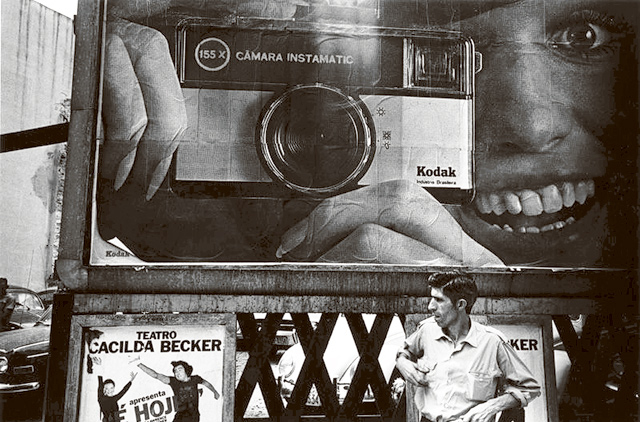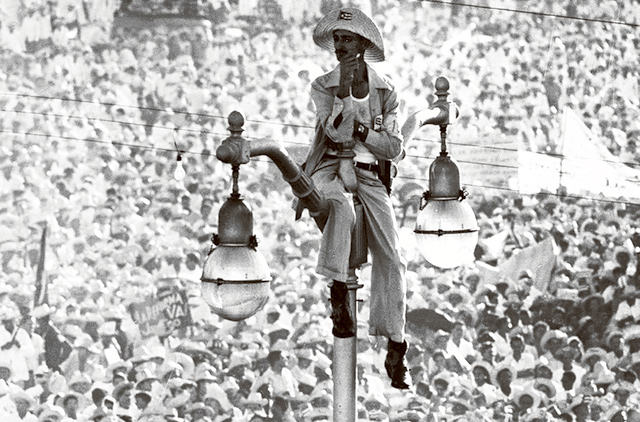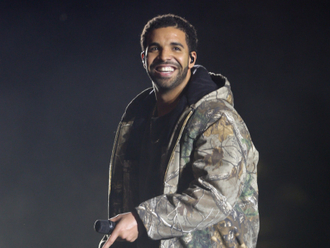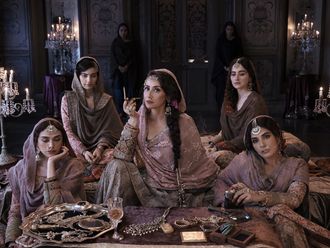
The photographer Alberto Korda, whose portrait of Che Guevara is very likely the most famous photograph of all time, was not a disinterested observer of the Cuban revolution. He was a close friend of Fidel Castro, and with his trusty Kodak 35mm camera he set out not only to document the overthrow of the Batista government, but to inspire it too. In one extraordinary image, a peasant farmer wearing a woven hat sits on top of a lamppost, casually smoking while thousands of flag-waving demonstrators march past. It’s 1959, and Cuba is about to be transformed into a socialist state, but the farmer in the air couldn’t be bothered: the revolution, he seems to say, is inevitable.
Korda’s photograph sits at the opening of Urbes Mutantes, a major new show of Latin American photography that opened on May 16 at the International Centre of Photography in New York. The exhibition, which arrives after an earlier outing in Bogotá, brings together more than 200 images from Argentina, Bolivia, Brazil, Chile, Colombia, Cuba, Ecuador, Mexico, Peru and Venezeula, spanning seven decades. That’s a lot of territory, and you could fairly ask whether a region that stretches from the American border all the way to Tierra del Fuego has any genuine coherence, and whether any one show can do justice to 70 years of photographic history. The panorama is broad, perhaps too broad; distinctions between art, journalism, street photography and other modes are elided. National histories remain hazy, and as the show is drawn from one major private collection there are some notable gaps (there’s nothing from Central America, for one, and Brazil is short-changed).
But what keeps this exhibition from dissolving into incoherence is the curators’ relentless focus on cities, and on the pressures and paradoxes of urban Latin American life. Teeming Sao Paulo, sprawling Mexico City, refined Buenos Aires, gracefully crumbling Havana: these “mutant metropolises”, as the show’s Spanish/Portuguese title has it, are the backdrop for the political and social transformations that Latin American photographers documented, and sometimes participated in themselves. Across the region and especially during the years of military dictatorship in Chile, Argentina, and elsewhere urban photography gave form to Latin American life in a way that official art rarely could.
Latin American cities are places of contradiction. Exacting modernist architecture butts up against shantytowns; built and natural environments shade into one another. In the late 1950s, as utopian Braslia was rising in the continent’s interior, the Brazilian artist Geraldo de Barros photographed buildings in an almost abstract register, and the images’ rigorously composed planes of glass and concrete attest to a moment of deep modern ambition. But every utopia is a failed utopia. Pablo López Luz, an excellent young Mexican photographer, shows us gates, doors and barriers in federal districts whose geometric patterns recall both Aztec art and international modernism but whose function, ultimately, is keeping the rich and the poor apart.
In the years of dictatorship, photojournalism played an integral role not just in recording history, but in reassuring the regimes’ opponents that their anger was being heard. Eduardo Longoni captures the Argentinian military parading through Buenos Aires, a monolithic mass of soldiers’ heads; they’re fearsome but they’re also slightly juvenile, as if their power could disappear in an instant. The most powerful images of that era, especially for an American audience, come from Chile — where in 1973 a brutal junta came to power in an American-backed coup that was one of the grimmest episodes of the cold war, one for which the United States has never fully atoned. Marcelo Montecino’s forbidding depiction of a military school, Álvaro Hoppe’s scene of a baton-wielding policeman framed by broken glass, Héctor López’s grim shots of protests in Santiago streets: these are essential images, though it’s too bad the US-fuelled conflicts of other Latin American nations (Uruguay, El Salvador, Guatemala) aren’t here also.
While the squares and boulevards of Latin American cities saw protest and oppression, life went on in the dark: in nightclubs, tango joints and bordellos. Chilean photographer Sergio Larran, a member of Magnum, shot the brothels of Valparaso, where modestly dressed women gaze at their shy-looking clients. Óscar Pintor, an Argentinian, captures an after-hours Córdoba, its hauntingly lit backstreets like something out of Borges. Paz Errázuriz produced stately, respectful portraits of gay and transgender Chileans who suffered under the Pinochet regime. More recently, Yolanda Andrade shoots transsexual prostitutes on a wide Mexico City boulevard; they may be marginalised and threatened by violence, but they’re embarrassingly beautiful.
No single portrait or panorama can stand for a region as giant and diverse as Latin America: that’s the credit of this show, if also its undoing. If anything, Latin American cities are best apprehended in the glaringly different ways one place can be seen by two photographers. Two shots from Tijuana — right on the border of the United States, and much closer to New York than Buenos Aires or Sao Paulo — stand out in particular. In one, by the photographer Yvonne Venegas, a millionaire bride prepares for her deliciously tasteless wedding, cradling an infant swaddled in lace. In the other, by Lourdes Grobet, a faceless man tries to sell trinkets in the traffic-choked streets of Tijuana, whose population has bloated thanks to ruinous free-trade agreements. Neither is a sufficient depiction of Tijuana on its own, but in the gaping space between them, you can start to plot a map of a region in constant, thrilling, worrisome, head-rushing flux.
–Guardian News & Media Ltd
Urbes Mutantes: Latin American Photography will run at the International Centre of Photography in New York through September 7.
Sidebar 1
Spanning seven decades, but focused particularly on works produced from the 1950s to the 1980s, Urbes Mutantes: Latin American Photography 1944–2013 offers a revision of how the continent’s cities have been imagined. The exhibition draws primarily on street photography and depictions of public space during periods of political and social upheaval. It is organised into sections that explore the street as a platform for protest, the formation of urban identities, popular street culture, and the public face of poverty.
“As the 20th century progressed, amidst struggles for social justice and in defense of democracy and freedom, the city became a setting for uprisings and revolutions,” says Guest Curator Alexis Fabry. “Images became as important as the stories covering the events that shaped these Latin American nations. In certain cases, politics and art were inseparable.”
Without attempting to provide an exhaustive account of Latin America’s photographic traditions, the exhibition spotlights alternative views of the region’s urban centres, bringing greater nuance to stock clichés or rigidly framed generic stereotypes. One of the challenges posed by this exhibition is to reveal how politically and socially committed visions can be paired with other types of urban documentation. These include formal experiments, such as abstract renderings of architecture and urbanization, or the more ironic and cynical works that emerged in the 1990s, which sought to question the region’s immutable truths and entrenched myths.
Comprising more than 200 images, the exhibition is drawn from the collection of Leticia and Stanislas Poniatowski, one of the most extensive private archives of Latin American photography.
–www.icp.org
Sidebar 2
Also on view: Caio Reisewitz
One of Brazil’s leading contemporary photographers, Caio Reisewitz (born 1967) has produced a remarkable body of work during the past 15 years, concentrating almost exclusively on Brazilian subjects. His large-scale colour photographs explore the changing relation of the city and the countryside in a period of feverish economic development. Many of Reisewitz’s photographs testify to his fascination with the architectural heritage of Brazil’s colonial period, as well as its innovative 20th-century modernist architecture. Other imposing works portray the pristine landscapes and dense forests around his hometown of Sao Paulo—areas that are now threatened by urban sprawl. His smaller-format photo collages take a very different direction, employing a playful, jazzlike visual approach. In these works, tiny photographic images of urban environments are scattered within scenes presenting the green expanses of Brazil’s forests. Reisewitz has frequently exhibited in South America and in Europe, and represented Brazil at the 2005 Venice Biennale. This is his first major solo show in the US.















